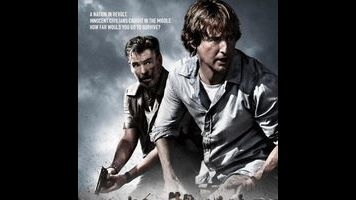Owen Wilson flees a coup in the incoherent No Escape

Despite its illegible chase scenes, awkward slow-motion shots, and fumbling attempts at political commentary, No Escape manages to be intermittently interesting, thanks to an off-beat supporting turn from Pierce Brosnan and the intrinsic curiosity factor of watching a film mishandle an inspired premise. Directed and co-written by B-horror journeyman John Erick Dowdle (Devil; As Above, So Below), the film stars Owen Wilson as Jack Dwyer, an American civil engineer who relocates with his family to an unnamed Southeast Asian country, only to have a coup topple the ruling military dictatorship on their first night there.
Said coup was motivated by the government’s corrupt ties with Western multinationals, which includes Jack’s new bosses at a water-pump company called Cardiff, whose welcome banner—bearing an unflattering photo of Jack and the other new hires—hangs ominously in the lobby of the Imperial Lotus hotel. Come morning, Jack, his wife Annie (Lake Bell), and two of the dumbest, most annoying children to ever grace an action movie find themselves being chased by red-scarf-wearing, machete-wielding bogeymen, who, the movie occasionally acknowledges, sort of have a point.
Part disaster-chase flick, part scare film meant to warn would-be parents that their kids will want to go to the bathroom or be told a story even when roving bands of killers are present, the movie stumbles from one set-piece into another, each an insight into how a seemingly foolproof set-up can be bungled by sloppiness. What makes No Escape’s slapdash sense of action all the more mystifying is the fact that the movie’s early scenes feature a number of long, carefully staged Steadicam shots, not unlike those in Dowdle’s earlier Devil, which efficiently link actions and build tension by placing them within the space of a single take. (A few scenes in No Escape are clearly edited down from longer takes, though it’s hard to tell whether the jump cuts are a deliberate stylistic choice or an instance of awkward re-cutting.)
Occasionally, the Dwyers run into Hammond (Brosnan), a cheroot-smoking globetrotter with intimate knowledge of the local taxi routes and brothels, often seen in the company of his buddy (Sahajak Boonthanakit), a cowboy-hatted jitney driver nicknamed “Kenny Rogers.” Brosnan, a leading man who has seamlessly aged into being a character actor, chews into the role of the full-time Western expat, a middle-age potbelly poking out from under his Hawaiian shirt as he enthusiastically belts out karaoke in the hotel bar.
Shot in Thailand, with Cambodian music blaring from local radios and signage in upside-down Khmer, No Escape attempts to interject some commentary about unchecked Western business interests while trying its darnedest to offend no one in particular. The result is as incoherent as the movie’s action scenes. Whether the Dwyers are trapped on a hotel roof or wading through a crowd of marchers in disguise, Dowdle—one of those protean genre directors who’s usually at his most interesting when trying to imitate someone else—manages to find a way to lose momentum or undercut suspense. Whether the camera is splattering over a hotel room in sub-Bourne handheld or overplaying a moment with slow-mo, the result is almost perversely fascinating to watch.